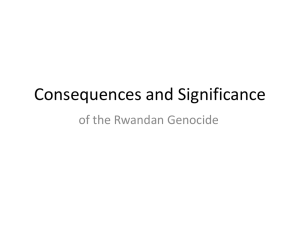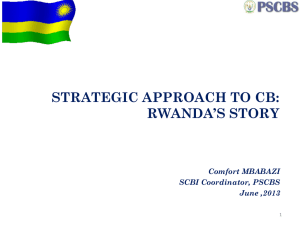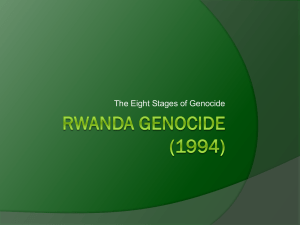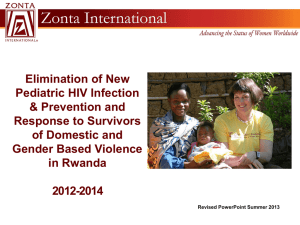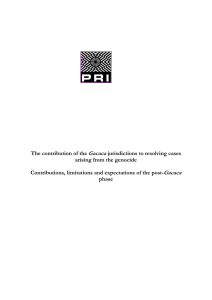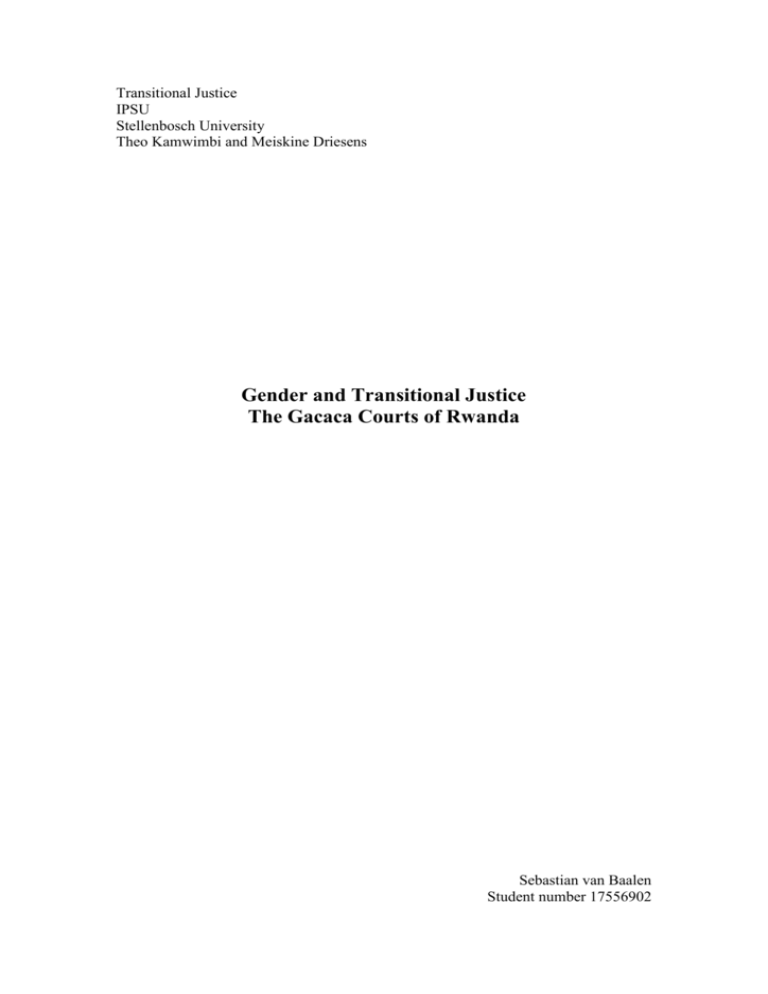
Transitional Justice
IPSU
Stellenbosch University
Theo Kamwimbi and Meiskine Driesens
Gender and Transitional Justice
The Gacaca Courts of Rwanda
Sebastian van Baalen
Student number 17556902
Introduction
The Rwandan genocide in 1994 marks one of the most brutal and deadly events in
human history, killing up to one million Tutsi, and Hutu moderates and displacing
millions. Furthermore, the aftermath of the genocide presented more, both moral and
practical dilemmas, for the new government. One was the issue of justice.
Women have mainly traditionally been seen as the victims of war. Even though men
are more likely to die in combat, women are extremely vulnerable to sexual and
gender-based violence, such as rape, forced conscription, sexual slavery, abduction,
forced pregnancy and forced HIV/AIDS infection. However, newer approaches show
a more multidimensional impact, identifying women as victims as well as
perpetrators, but also in instrumental roles promoting peace and stability in postconflict situations (M’Cormack-Hale, 2012, p.3). In Rwanda, sexual violence against
women was executed on a massive scale, both by Hutu militias, civilians and the
Rwandan armed forces. This violence was not random, but was encouraged in a
systematic way aiming at the destruction of the Tutsi as a people. The offences ranged
from rape, gang-rape, abuse, sexual slavery and/or forced marriage and sexual
mutilation. Many victims were also killed and tortured. According to estimates,
between 250 000 and 500 000 women were raped during the genocide (Brounéus,
2008, p.60; HRW1, 1996, p.2).
This paper focuses on one of the justice mechanism introduced in Rwanda after the
genocide, the gacaca courts, and specifically attempts to highlight the implications for
victims of gender-violence during and after the process. As Wells (2005) points out,
even though critique against the gacaca courts has been widespread, “there is no
existing analysis involving a study and critique of the gacaca model against the
experiences and perspectives of the female survivors of the Rwandan genocide”
(p.169). My research question will thus be:
Have women been affected differently to men by the traditional gacaca courts in
Rwanda and why?
The paper will consist of four parts, starting with introducing the traditional gacaca
court and its evolution into the post-genocide gacaca court. Thereafter I will turn to
2
the theoretical framework on truth-telling and justice in post-conflict settings and its
affects on women. The third part will consist of a short case study on women in the
gacaca courts. I will end by making some conclusions and final remarks. It should be
noted that I do not intend to present the background of the Rwandan genocide or
gender-violence during the genocide in any further detail due to space limitations.
The Gacaca – a traditional form of justice?
It has long been the standard to refer to the local courts in Rwanda, the gacaca, as an
inherently traditional form of justice with which all Rwandans can intuitively identify.
This approach is commonly romanticised by foreign journalists and scholars, but it is
also popular among certain elements of the Rwandan government. Far from being a
solely indigenous institution, as Cambridge scholar Clark (2010) notes, the gacaca
should be seen as a hybrid institution, inspired by indigenous and endogenous forms
of justice – the gacaca is a process rather than a static traditional system (pp.49-50;
HRW, 2011, p.17).
In its traditional form, the gacaca was in many was different from the modern postgenocide version. American anthropologist Burnet (2008), who has conducted field
studies in post-genocide Rwanda, argues that rather than being a public matter, the
gacaca was traditionally a private form of justice, held in private, and usually even
keeping the ‘judgement’ or decisions confidential. The gacaca has even taken its
name from the grass of the inner courtyard of a traditional Rwandan home, the
igikari, traditionally the most private domain of the household (p.175).
Regional varieties in the forms and practices of the gacaca most likely existed, but
some main characteristics can be traced. The leaders of the gacaca were village elders,
the Inyangamugayo, working as mediators rather than judges. Normally, the aim of
the gacaca was restorative justice rather than retributive justice; the wrongdoer was
typically obliged to give reparations, acknowledge his or her wrongdoing and initiate
some form of reconciliation. Only more serious offences would result in the offender
being excluded from the community or turned over to government chiefs for
retributive justice. Women usually did not participate, since they were not allowed to
speak (Clark, 2010, p.53; Harrell, 2003, p.67, HRW, 2011, p.17). Further, the gacaca
3
was first and foremost concerned with restoring social harmony, victims’
compensation and punishment being secondary (HRW, 2011, p.17).
If the gacaca was traditionally an informal justice process, Belgian colonization
introduced it as formal, institutionalised and stratified. By appointing Tutsi
administrators to maintain order at the local level, the elders of the gacaca
increasingly became appointed by the colonial administration rather than by the
families involved in disputes. Alongside the gacacas, the colonisers introduced
Western courts based on Belgian law. Cases involving the local populations were
handled by the gacaca, while the ‘modern’ courts handled cases involving foreigners
(Clark, 2010, pp.53-54; Burnet, 2008, p.176).
The modern version of the gacaca was introduced as a response during the aftermath
of the 1994 genocide in Rwanda. Five objectives were specified by the government:
(i) revealing the truth, (ii) speeding up the genocide trials, (iii) eradicate the culture of
impunity, (iv) promote reconciliation and (v) prove that Rwandan society has the
capacity to settle its own problems (National Service of Gacaca Jurisdictions, n.d.).
However, the modern gacaca courts in Rwanda were in many ways different from the
traditional court. A Human Rights Watch (HRW) report points out five main
differences; the nature of the crimes handled, the nature of justice, the gacacas
governance, the law applied and the appointment of the elders. Given that traditional
gacacas were first and foremost concerned with minor disputes, handling genocide
crimes naturally posed serious obstacles to these courts. Also noteworthy is the
change in the nature of justice advocated, from being concerned with social harmony
to imposing prison sentences up to life-time sentences (2011, p.18).
During the years when the gacacas were operating, it involved the entire country, with
local communities holding gacaca meetings once a week. The court consisted of nine
selected judges, the villagers, the accused and the witnesses, and was at the same time
a court and a truth and reconciliation commission (Brounéus, 2008, p.57). Due to the
vast number of cases, ranging up to 100 000, the gacaca court was introduced as a
way of dealing with cases not dealt with by the other to justice mechanisms, the
International Criminal Tribunal for Rwanda (ICTR) and the national courts. Alleged
crimes were classified into four categories, with category one including planners,
4
leaders, organizers and instigators of the genocide, well-known killers and rapists;
category two including persons who committed homicide; category three persons who
killed or inflicted bodily harm without the intention to kill; and category four
including those who stole or damaged property. The gacacas were given jurisdiction
to judge all suspects of category two, three and four crimes, committed between
October 1, 1990 and December 31, 1994. Category one crimes were left for the
national courts and the ICTR (HRW, 2011, p.11-12).
Theoretical framework
Since the first versions of truth and reconciliation commissions were held in
Argentina and Chile in the 1980s, they have become an important part of peacebuilding. Much is based on the assumption that truth-telling is cathartic or healing,
and thus is a mean of reconciliation. But as Brounéus (2008) from the Department of
Peace and Conflict Research in Uppsala, Sweden has pointed out, this notion tends to
be based on intuitivism rather than empirical evidence. According to her research,
there is an immediate risk for retraumatization of victims based on psychological
research (pp.56-57).
Most of the support for truth-telling as a healing and reconciliation mechanism comes
from theological thinking. Some form of spiritual dimension to the practise is often
the case, as with the South African Truth and Reconciliation Commission (TRC) and
its leader Archbishop Desmond Tutu. Psychoanalytical theory has also inspired the
idea, where testimony is seen as an important ritual for individual healing. However,
there is a lack of empirical evidence for the assumption of truth-telling as healing
(Brounéus, 2008, p.58). As Kotzé (2002) points out,
“We still await studies about the psychological impact of truth commissions, their
function as a potential means of conflict resolution and prevent, and their
significance and symbolic value for political communication and political
socialization” (p.166).
Similar flaws are pointed out by Medeloff (2004) as he concludes that “many such
claims – and their core assumptions – are flawed or highly contentious” (p.355),
highlighting that the theory about truth-telling dictates far more than evidence
5
suggests. Brounéus mentions several psychological studies suggesting two risks
associated with truth-telling. First, truth-telling can be seen as a form of early
psychological intervention after trauma, so called one-session debriefing, which
increases the risk of post-traumatic stress disorder (PTSD) and depression. Secondly,
as studies from the South African TRC suggests, there was an imminent risk of
retraumatization for individuals giving testimony before the TRC (Brounéus, 2008,
p.60).
Other scholars (Goldblatt and Meintjes, 1996) that studied the South African TRC
found that female victims of apartheid experienced consequences that men did not,
from truth-telling, public disclosure and dialogue. This was since women, and female
victims of sexual violence in particular, faced a disproportionate degree of shame,
social stigma and condemnation both by society as a whole and their local
communities. Mutua, a professor of law and human rights, (2008) suggests that this
can be even more problematic in societies such as Rwanda, where cultural
imperatives do not acknowledge rape within our outside marriage and where genderbased violence is blamed on the victims rather than the perpetrators. Despite the fact
that systematic violence against women as a group has been revealed in cases like
Rwanda, both the public and the international community has largely failed to address
the issues appropriately. Women in genocide are not only targeted as part of an ethnic
group, but also because of their gender. Further, Mutua argues that this failure is not
only the result of imperfect transitional justice mechanism, but must be seen in the
light of a broader invisibility and marginalization of women in public life in general
(p.20-21).
Related with these issues is also a broader failure to investigate gender-violence fully,
as ‘gender’ is thought of as synonymous to ‘women’. This fails to highlight the
particular ways that men are also victims of gender-violence in conflict. Meintjes
(2009), who has studied the South African Truth and Reconciliation Commission
(TRC) points out that men become both direct subjects of sexual-violence in conflict,
such as sodomy, and indirectly through having to watch family and relatives being
subject to sexual assault. Assaulting a man’s wife is systematically used as a way to
‘unman’ men, directly undermine their feeling of responsibility to protect their
6
families. To fully understand the nature of sexual violence against women in conflict,
gendered violence against men must also be systematically investigated (p.108).
It has also been suggested, by Wells (2005), that since women are in general more
vulnerable in post-conflict situations, they are more dependent on their communities
and thus more susceptible to community pressure (pp.183-184). According to
American anthropologist Burnet (2008), courts are technologies of memory, which
produce, challenge and legitimize memories of human atrocities. Therefore, any
process that marginalizes a specific group of people, such as women, must be seen as
a threat to the public memory (p.758). In Mutua’s words, “… [the] failure to centre
gender in the understanding of sexual violence erases women from the face of
genocide an treats them as non-existent” (2008, p.21).
Burnet further emphasises that there has been a tendency to view the Rwandan
genocide as a ‘gendercide’, focusing only on the mass-killings of Tutsi men and not
on the vast sexual violence experienced by Tutsi women (p.763). Creating collective
memories of gendered and sexual violence is difficult and poses serious complications
for post-conflict states. These difficulties are summarized by Rehn and Johnson
Sirleaf (2002) as they note that
“Yet for … [truth commissions] to serve women, their mandates must reflect the
nature of the human rights violations that women suffer. The stigma associated
with reporting sexual violators and the issue of witness protection must be
addressed.” (p.13).
Testifying in the traditional courts is also associated with other both legal and social
risks. HRW refers to Rwanda’s “ill-defined laws on ‘divisionism’ and ‘genocide
ideology’”, as these laws pose potential risks to witnesses in the gacaca, especially for
defence-witnesses, of being prosecuted themselves. Even more worrying could be the
lack of witness protection, which could especially endanger widowed women (HRW,
2011, p.87).
I will now turn to the case study of the gacaca courts in Rwanda with regard to the
points stressed above: (i) the implications of testifying on women’s mental health, (ii)
7
the risk of social stigma, (iii) the marginalization of women’s experiences as part of a
collective memory and (iv) legal issues, including the problem of witness protection.
Women and the gacaca
Implications on mental health. In her field research from Rwanda, Brounéus
specially focused on women’s mental health with regard to their testimonies in the
gacaca courts. She found that, in line with the theory outlined above, women who
testified before the gacaca showed intense psychological suffering, among that signs
of traumatisation and depression. None of the interviewees in Brounéus study (n=16)
considered giving testimony as a healing experience as proposed by theories on truthtelling. Rather, the process was experienced as retraumatization, in Brounéus words,
“they saw the machetes, heard the noises, smelled the smells” (2008, p.71). HRW
noted that some of the women testifying of rape received counselling before and
during the trial, but many did not due to the lack of trauma counsellors (HRW, 2011,
p.116). However, despite the difficult psychological aspects encountered by female
victims, women’s rights activists in Rwanda view women participation in the gacaca
as essential, both for revealing the entire truth, but also since women constitute the
majority of the survivors and thus ‘know the truth’ (Wells, 2005, pp.183-184).
The risk of social stigma. Many women testifying about sexual violence before the
gacaca have since reported on the social stigma experienced as a response to their
testimony. HRW mentions several cases where the victims were met with stonethrowing, written threats and social exclusions, whereas others even faced the risk of
renewed exposure to the perpetrators (HRW, 2011, p.118). Brounéus further
underlines that for all the women faced with social stigma in her research, the
insecurity began with the gacaca. They were attacked both physically and
psychologically and were subject to threats, harassment and violence. This insecurity
for women as a result of testifying in the gacaca has not received enough attention so
far. As Brounéus concludes, the women “are threatened and harassed before, during,
and after giving testimony in the gacaca. This is a picture of a reconciliation process
we seldom see” (2008, p.71-72).
8
Some aspects of truth-telling increases both the risk for social stigma, and might be a
difficult mental process as well, such as Tutsi women testifying against their Hutu
husbands and the fact that non-Tutsi women are not considered as survivors according
to Rwandan law (Thomson and Nagyy, 2010, p.16-17).
Marginalization of women’s experiences. In her field research from Rwanda, Wells
(2005) found that there are five times more female widows and that they head
households with significant fewer material resources than men. This vulnerability
makes them more dependent on community support, which in turn makes them more
susceptible to community pressures. Given the sexual nature of many of the crimes
committed on women, these pressures may discourage female victims from disclosing
sexual crimes and consequently identify themselves as victims of sexual crime. In
conclusion, marginalization of female victims in the gacaca has severe implications
for the establishment of truth and lead to increased impunity for perpetrators of sexual
violence. It also fails to make gender-related violations part of the collective memory
(pp.183-184; Nessel, 2007, p.111). This vulnerability has also been stressed by others
that note that at the root of sexual and gender-based violence lies economic and
political powerlessness. Failing to address questions of economic, social and cultural
inequalities is a major problem for transitional justice mechanisms, in Rwanda and
elsewhere, which affects men in general and women in particular (Meintjes, 2009,
p.109; Mutua, 2008, p.17).
Legal issues and witness protection. Since genocidal rape is defined as a category
one crime in post-genocide Rwanda, it can only be tried in the national court system.
However, cases are first tried in the gacaca courts and thereafter carried out by the
national court system. Although Nessel (2007) notes that this certainly serves a
normative purpose in making a statement of the seriousness of the crime, it poses
several difficulties to female victims. First, it threatens to re-traumatize victims since
they need to go through their experiences almost ‘for nothing’ in the public sphere of
the gacaca. Secondly, since national courts are weak and lack the time and ability to
prosecute perpetrators in the way the gacaca does, these crimes and victims tend to be
marginalized. And thirdly, extensive training of judges in gender sensitivity, and the
high percentage of female judges, has mainly been concerned with the gacacas and
9
the ICTR, so the national courts are by far the least appropriate venue for rape
prosecutions (p.103).
After their victory, the Rwandan Patriotic Front (RPF) is known to have raped Hutu
women in acts of revenge, with the purpose of impregnating them and in that way
replenish the decimated Tutsi population. The widespread impunity of perpetrators
from the RPF side thus also serves as impunity for sexual violence (Scanlon and
Motlafi, 2009, p.310). HRW reports that people accusing the RPF of crimes faced the
risk of trial themselves on charges of “genocide ideology” (2011, p.87).
Finally, although essential, witness protection has been largely lacking in the gacaca
courts (Nessel, 2007; Brounéus, 2008). HRW reported that threats and intimidations
of witnesses were common, and in some cases witnesses were even killed. According
to the same report the rate of killing witnesses more than quintupled during the time
of the gacaca, and between 2004 and 2008, 120 individuals were killed (HRW, 2011,
p.87).
Conclusion
This paper has examined the affect of the ‘traditional’ gacaca court in post-genocide
Rwanda and its implications for women. Rather contrary to popular (and scholar as
well) perceptions about truth-telling as healing, this examination points out four
different negative aspects of the gacaca for women. First, we must acknowledge the
complex psychological process of truth-telling as a healing process, and build our
conclusions on scientific research rather than theological intuitivity, in order to design
appropriate responses. Secondly, we must understand and deal with the fact that
women face special difficulties during truth-telling processes, such as social stigma,
which requires special attention. Thirdly, if not dealt with properly, women can be
pressured and even discouraged from testifying, which not only leads to impunity for
perpetrators of sexual crimes, but also leaves big holes in what we call collective
memory. And fourthly, legal matters must bring these aspects into account and further
acknowledge the immediate need for witness protection.
These conclusions do not argue against the use of traditional justice mechanism such
10
as the gacaca, but rather stresses the fact that any transitional justice mechanism,
whether new or traditional, must both acknowledge and deal with the special
difficulties raised by gender-related violence.
11
References
Brounéus, K., 2008. Truth-Telling as Talking Cure? Insecurity and Retraumatization
in the Rwanda Gacaca Courts. Security Dialogue, 39(1), pp.56-76.
Burnet, J.E., 2008. The Injustice of Local Justice: Truth, Reconciliation, and Revenge
in Rwanda. Genocide Studies and Prevention, 3(2), pp.173-193.
Clark, P., 2010. The Gacaca Courts, Post-Genocide Justice and Reconciliation in
Rwanda: Justice without Lawyers. Cambridge: Cambridge University Press.
Goldblatt, B. and Meintjes, S., 1996. Dealing with the aftermath: sexual violence and
the Truth and Reconciliation Commission. Agenda: Empowering women for gender
equity, 13(36), pp.7-18.
Harrell, P.E., 2003. Rwanda’s Gamble: Gacaca and a New Model Of Transitional
Justice. Lincoln: iUniverse, Inc.
Human Rights Watch, 1996. Shattered Lives: Sexual Violence during the Rwandan
Genocide and its Aftermath. [pdf] New York: Human Rights Watch. Available at:
<http://www.hrw.org/sites/default/files/reports/1996_Rwanda_%20Shattered%20Live
s.pdf> [Accessed 26 August 2012].
Human Rights Watch, 2011. Justice Compromised: The Legacy of Rwanda’s
Community-Based Gacaca Courts. [pdf] New York: Human Rights Watch. Available
at: <http://www.hrw.org/sites/default/files/reports/rwanda0511webwcover.pdf>
[Accessed 26 August 2012].
Kotzé, D., 2002. Truth Commissions and Formulas: Truth versus Justice: The
Morality of Truth Commissions by Robert I. Rotberg; Dennis Thompson. Review by:
Dirk Kotzé. International Studies Review, 4(1), pp.166-171.
M’Cormack-Hale, F.A.O., 2012. Gender, Peace and Security: Women’s Advocacy in
Conflict Resolution. London: Commonwealth Secretariat.
Meintjes, S., 2009. Gender and Truth and Reconciliation Commissions. In: C. Lekha
Sriram and S. Pillay, ed. 2009. Peace Versus Justice? The Dilemma of Transitional
Justice in Africa. South Africa: University of Kwa-Zulu-Natal Press, pp.96-112.
Mendeloff, D., 2004. Truth-Seeking, Truth-Telling, and Postconflict Peacebuilding:
Curb the Enthusiasm? International Studies Review, 6, pp.355-380.
Mutua, M., 2008. Interrogating Transitional Justice: Sexual and Gender-based
Violence. In: Unfinished Business: Transitional Justice and Women’s Rights in
Africa. [pdf] Nairobi: Agency for Cooperation and Research in Development (Acord).
Available at: <http://www.acordinternational.org/silo/files/unfinished-businesstransitional-justice-and-womens-rights-in-africa.pdf> [Accessed 27 August 2012].
12
National Service of Gacaca Jurisdiction, n.d. The Objectives of the GACACA Courts.
[online] Available at: <http://www.inkiko-gacaca.gov.rw/En/EnObjectives.htm>
[Accessed 26 August 2012].
Nessel, L.A., 2007. Rape and Recovery in Rwanda: The Viability of Local Justice
Initiatives and the Availability of Surrogate State Protection for Women That Flee.
Michigan State Journal of International Law, 101, pp.101-135.
Rehn E., and Johnson Sirleaf, E., 2002. Women, War, Peace: The independent
experts’ assessment on the impact of armed conflict on women and women’s role in
peacebuilding. [pdf] UN Women. Available at:
<http://saynotoviolence.org/sites/default/files/MediaKit_eng_0.pdf> [Accessed 27
August 2012].
Scanlon, H. and Motlafi, N., 2009. The Modern Gacaca Courts of Rwanda. In: C.
Lekha Sriram and S. Pillay, ed. 2009. Peace Versus Justice? The Dilemma of
Transitional Justice in Africa. South Africa: University of Kwa-Zulu-Natal Press,
pp.301-314.
Simiyu, V.G., 1987. The Democratic Myth in the African Traditional Societies. In:
W.O. Oyugi and A. Gitonga, ed. 1987. Democratic Theory and Practice in Africa.
Nairobi: East African Educational Publishers Ltd, pp. 49-70.
Thomson, S. and Nagyy, R., 2010. Law, Power and Justice: What Legalism Fails to
Address in the Functioning of Rwanda’s Gacaca Courts. The International Journal of
Transitional Justice, n.i., pp.1-20.
Wells, S.L., 2005. Gender, Sexual Violence and Prospects for Justice at the Gacaca
Courts in Rwanda. Review of Law and Women’s Studies, 14(2), pp.167-196.
13

